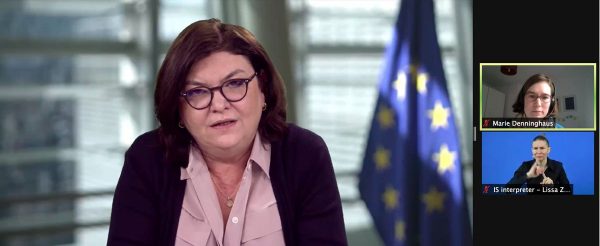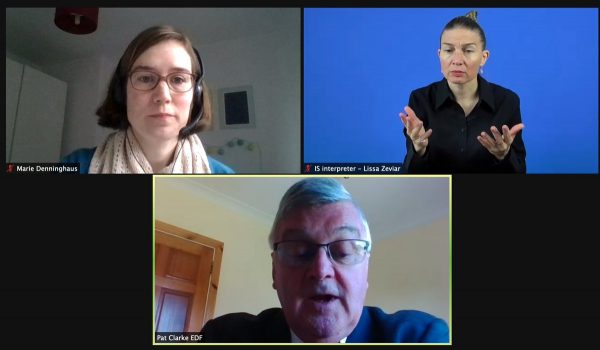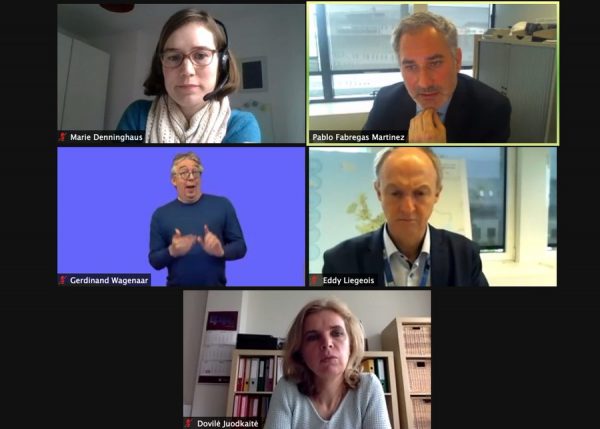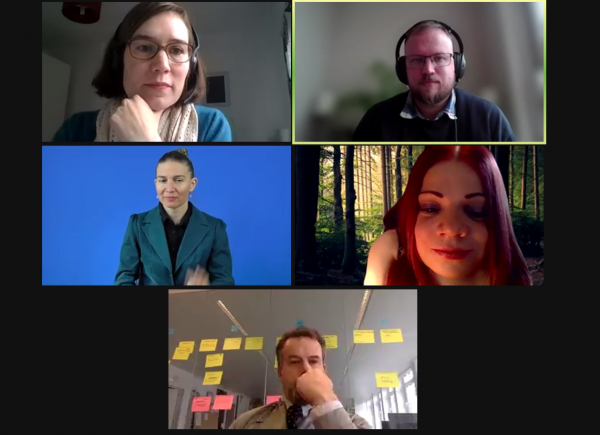EDF celebrates “European Year of Rail” highlighting importance of accessible rail for inclusive and sustainable future for all in the EU.
On 27 May, EDF held an online conference within the “European Year of Rail” to highlight the importance of accessibility of rail travel for everyone, especially passengers with disabilities. More concretely, the conference aimed to give overview of existing EU legislation in the field of rail accessibility, create awareness about the access needs of persons with disabilities and the current barriers to independent and spontaneous rail travel, and encourage further discussion on how we can achieve accessibility.
The conference was opened by a video address of the EU Commissioner for Transport Adina Ioana Vălean and EDF Vice President John Patrick Clarke.

In her opening address Commissioner Vălean noted that accessibility is a key theme for the European Year of Rail and crucial for making rail an attractive mode of transport for all passengers. She recognised that there are still many barriers to spontaneous and independent rail travel and expressed her and Commission’s determination to improve things further. She highlighted achievements brought by the Rail Accessibility Regulation (TSI-PRM), the recast Rail Passengers’ Rights Regulation, and the foreseen benefits of the European Accessibility Act. She closed her speech by inviting further input on how the European Union can improve rail to ensure it benefits everyone in the EU.
On behalf of EDF President Yannis Vardakastanis, EDF Vice President John Patrick Clarke thanked the Commissioner for her support and commitment to improve rail travel for persons with disabilities. He reaffirmed the achievements mentioned by the Commissioner in relation to EU legislation and noted that those were also the result of strong advocacy by the disability community in Europe. He then expressed hope that, building on the strong ground set by the European Strategy for the Rights of Persons with Disabilities and the Sustainable and Smart Mobility Strategy, accessibility of rail will be further improved through the revision of EU policies such as the TEN-T Guidelines and the Urban Mobility Package.

Following the opening remarks, to kick-start the discussion about rail accessibility, the program featured “Everyone Mobile!” – a video campaign (in Dutch) by the Belgian organisation VFG, demonstrating the daily barriers persons with disabilities face while trying to use rail services.
The main program of the conference consisted of two sessions. The first session focused on EU policies which aim to improve accessibility of rail travel and the national implementation of those policies. The second presented concrete examples of barriers for persons with disabilities, as well as some practical solutions to address those barriers.
EDF Policy Coordinator Marie Denninghaus moderated the first session asking questions to the three panellists: Pablo Fabregas Martinez, Member of Cabinet of EU Commissioner for Transport, Eddy Liégeois, Head of Unit, DG MOVE, European Commission, and Dovilė Juodkaitė, President of the Lithuanian Disability Forum.
Mr Martinez started the discussion by answering how the European Union is improving accessibility of rail for persons with disabilities within the Year of Rail and beyond. In his answer Mr Martinez mentioned again the two EU laws which aim to improve equal right of passengers with disabilities to travel by rail. Those are the recast Rail Passengers’ Rights Regulation, which has shortened pre-notification time for assistance (24h), obligatory training for assistance personnel, the right to bring an assistance dog on board, and compensation for lost or damaged equipment or assistance dog. The other EU law he mentioned was TSI-PRM, which provides technical specifications for accessible rail stations and trains. To better apply this law, the European Commission is trying to develop a concrete Action Plan.
Mr Eddy Liégeois, the Head of the Unit responsible for multi-modal transport from DG MOVE of the European Commission then explained what the TEN-T Regulation is, what the accessibility requirements in the TEN-T are and what can further be improved. He introduced TEN-T as a legal framework for the development of multimodal infrastructure, including roads, highways, rail networks, as well as ‘urban nodes’ which are basically the airports, and transport terminals. Article 37 of the Regulation requires that TEN-T infrastructure allows seamless mobility and accessibility for all users, including persons with disabilities. Member States must comply with this demand when they use EU funding to develop infrastructure. To improve TEN-T the European Commission is planning to revise it. One of the concrete ideas that Mr Liégeois proposed for improvement is to expand the TEN-T requirements to the most important cities in the network. This can be done by sustainable urban mobility plans (SUMPs) – measures taken by the cities to develop transport systems which are accessible for all users.
After the introductory remarks by EU policy-makers, Ms Dovilė Juodkaitė shared their experience being involved in the implementation of EU rail accessibility law in Lithuania. She shared that after initial reluctance by national authorities to effectively improve accessibility of rail infrastructure, thanks to the strong advocacy of national organisations of persons with disabilities (DPOs), in 2019 the Lithuanian Disability Forum, the Lithuanian Railway Group, and the Ministry of Transport signed a memorandum of understanding with the main purpose to implement EU regulations through a national plan with concrete deadlines and milestones until 2024. The plan is based on four major pillars: first of all, to improve accessibility of information systems, secondly, to make stations and infrastructure physically accessible, thirdly, to provide support services during the whole trip, and lastly, to ensure accessibility of trains. Ms Juodkaitė regretted however that national authorities do not see improving accessibility as their primary obligation, and DPOs constantly have to advocate and work with responsible authorities to ensure that EU law is implemented. So, she highlighted, there is very clear need for strong monitoring and enforcement mechanisms both at the EU and national level. Lastly, Ms Juodkaitė stressed that since rail systems are not confined within national borders, there needs to be strong cooperation between EU countries and harmonization of accessibility at EU-level.
After this first round of questions, Mr Martinez explained how the European Commission’s Smart and Sustainable Mobility Strategy can improve accessibility of rail for passengers with disabilities. The Strategy is sort of an Action Plan for the coming years to improve EU transport. The three important points for persons with disabilities are the revision of TEN-T, which was already explained above, the revision of the EU’s urban mobility package, which will aim to oblige certain important cities to implement the above-mentioned SUMPs and encourage all others to do as well, and lastly an exercise of mapping of obstacles and barriers in rail infrastructure. He also mentioned an important point on funding for TEN-T infrastructure: an obligation to ensure accessibility of railway lines and possibility to use funds to improve accessibility of train stations.
Mr Liégeois then answered what the added value of TEN-T is and how it will support other EU policies on improving rail travel for persons with disabilities – namely TSI-PRM. He reinstated the European Commission’s commitment to ensure equal access to mobility to all. However, he noted that the aim of the TEN-T is not to incorporate detailed rail accessibility requirements, which is the role of the TSI-PRM. Rather, the TEN-T focuses on the overall infrastructure and making links between different transport policies.
Before turning to questions from audience, Ms Juodkaitė answered what the main shortcomings in ensuring accessibility at national level are. She mentioned three things. Firstly, accessibility of infrastructure around rail travel is often very poor. For example, the parking stops or pedestrian crossing around the train station are often not under the ownership of the rail service but municipality, so these can create barriers even if the rail service itself is accessible. Secondly, there are funding and spending issues, especially when it comes to buying accessible trains. And lastly, it is often the case that accessibility is formally met but there is no quality control, so in practice an “accessible” station might not actually be accessible for many persons with disabilities. This is why, Ms Juodkaitė highlighted, it is crucial to cooperate with DPOs and meaningfully consult passengers with disabilities.

The moderator then opened the floor for questions. Participants were interested to know how the participation of users will be ensured in developing the revised TEN-T. Mr Liégeois welcomed input from EDF, other DPOs and individuals on what the European Commission can improve through the revision of the TEN-T and expressed openness to consider them. The moderator Ms Denninghaus reminded participants that anyone can give feedback to the European Commission during development or revision of EU policies through online public consultations.
There was a specific question whether Ireland as an island country can benefit from EU funding related to TEN-T. Mr Martinez mentioned that as an EU member country Ireland has the same eligibility for EU funding as others. He explained though that the proposal of a project to improve accessibility must come from the national authorities. So, country governments have freedom which types of projects they want to prioritize and ask funding for.
The last question was about universal design and whether speakers think there is enough knowledge in the rail sector about this. Ms Juodkaitė mentioned that this was one of the remaining issues and that there is need for more best practice sharing and harmonization across the EU, to ensure that rail accessibility is improved based on a universal design principle, having in mind wide diversity of users.
After a short break, moderator Ms Denninghaus introduced the speakers of the second session, who focused on concrete barriers faced by passengers with disabilities and some good practices for solutions to address those barriers. Soufiane El Amrani, self-advocate and easy-to-read expert from Inclusion Europe, Laura Alčiauskaitė, project coordinator of TRIPS from the European Network on Independent Living (ENIL), and Blaž Pongračič, senior policy adviser on passengers from the Community of European Railway and Infrastructure Companies (CER) took the floor one after the other to present their contributions in a traditional ‘webinar style’.
Mr El Amrani started the session by presenting his experience as a person with disability in accessing trains in Belgium. He needs to give a 48-hour notice in advance for assistance. He also noted that many stations in the EU do not have services for persons with intellectual disabilities. He made concrete recommendations for improvement: train timetables and ticketing machine information must be written in easy-to-read and in Arial 14. But also, there are issues when trying to get to a train station. For example, he was once discriminated by a bus driver and not allowed to enter the bus. It turned out that the driver was new and did not have proper training. There are even barriers when using a private taxi, as you need to call a few days in advance to reserve it. All these barriers stop persons with disabilities, including intellectual disabilities, from being able to travel by rail spontaneously and independently, like everyone else.
Ms Alčiauskaitė then presented results of a research conducted within the TRIPS project. The project brings together different partners, including organisations of persons with disabilities, city authorities, transport services, to co-produce accessible transport solutions in seven European cities – Bologna, Brussels, Cagliari, Lisbon, Sofia, Stockholm, and Zagreb. But of course, to create solutions, first the obstacles need to be identified. That is why, within the project, Ms Alčiauskaitė and colleagues conducted interviews with persons with different disabilities about the barriers they face when trying to access public transport. The results showed that there are still many unresolved issues when it comes to accessibility of rail services. Most of them are related to early pre-booking times, lack of assistance, inaccessible vehicles and infrastructure, and the inconsistent design of stations and stops. The barriers are not only environmental but also social, for example discriminatory attitude from staff and other passengers towards persons with disabilities. Most of the investment was done in engineering solutions: ramps to enable people in wheelchairs to change level; audio information to support visually impaired people. Mental health aspect is clearly overlooked when improving accessibility and passenger experience in rail travel.
Mr Pongračič concluded the session by presenting what some of the rail companies within their network are doing to improve accessibility for their customers with disabilities. Presenting the practices of three European rail companies, the German Deutsche Bahn, French SNCF, and the Dutch NS, he presented four main areas in which these companies are trying to improve: digital solutions, access to trains, amenities on board, and cooperation with user representatives. The digital solutions are provided through mobile apps. For example, with the German “Bahnhof live” App, passengers can find in advance whether there is a step free access at the respective station. There is also a list of all the elevators which can be found at that station. SNCF developed a digital solution to provide information to Deaf passengers through visual information. This way they can read the written text of audio announcements on their mobile. In the Netherlands, the Dutch railways are implementing sliding steps in trains so that passengers with wheelchair or other mobility aid can travel spontaneously and independently. The long-term plan is to ensure this in all Dutch trains by 2045. Deutsche Bahn also plans stepless and independent access to the new „ECx“Talgo trains which will start operating in 2023. An example of amenities on board was presented from SNCF, which has tactile indicators on the toilet door look, indicating if the toilet is free or occupied. SNCF also conducts monthly meetings between railway operators and infrastructure managers with participation of French organisations of persons with disabilities.

The conference was closed by EDF General Secretary Gunta Anča. She started by summarizing the main observations and input by the conference speakers. She then noted that we are at a crucial point of the policy agenda and have the opportunity with the on-going revision of the TEN-T Regulation and the upcoming revision of the Urban Mobility Package to make rail accessibility a reality. Ms Anča made some concrete recommendations for improving rail accessibility. She called on the European policy-makers to strengthen and mainstream accessibility requirements, including by addressing barriers of vehicles and urban rail infrastructure through the revised TEN-T Regulation, to make accessibility a binding requirement when allocating EU funding for the TEN-T network and report on how accessibility is implemented in practice, and to make accessibility an obligatory part of Sustainable Urban Mobility Plans and ensure that it includes rail connections as well as intermodal links.
She also highlighted the importance of proper implementation and enforcement of existing EU law on rail accessibility (TSI-PRM) and passenger rights (recast Rail Passengers Rights Regulation). Finally, she stressed that political will and legislation can only be realized if there is sufficient public funding allocated to improve accessibility. In this context, she called on the national governments to make good use of available public funds such as European funding instruments of Connecting Europe Facility and Resilience and Recovery Fund.

Background documents:
- EDF Rail accessibility conference brief – 27 May 2021 (Word)
- EDF Rail accessibility conference brief – 27 May 2021 (PDF)
Speaker presentations:
- Soufiane El Amrani, Self-advocate, easy-to-read expert, Inclusion Europe: accessibility barriers for persons with intellectual disabilities
- Laura Alčiauskaitė, Project coordinator, European Network on Independent Living (ENIL): barriers in rail services: perspective of persons with disabilities
- Blaž Pongračič, Senior Policy Adviser Passenger, Community of European Railway and Infrastructure Companies: Good practice example of accessible rail services
Questions and Answers:
Find the main questions answered in this document.
Contact:
Mher Hakobyan, EDF Accessibility Officer, mher.hakobyan@edf-feph.org.
Please note, EDF cannot guarantee accessibility of audiovisual material (external links, speaker presentations) which are not produced by us.